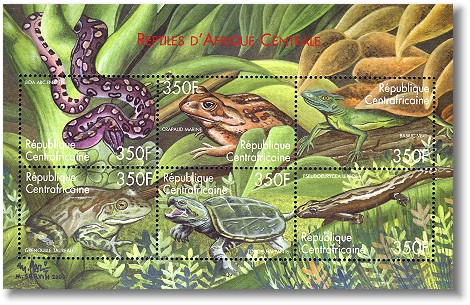Unfortunately, the disease seems to be winning and its price may be the extinction of frogs, toads and salamanders. The disease, called chytridiomycosis, or chytrid for short, has been decimating amphibian populations at least since the late 1980s. Amphibians (class Amphibia) are cold-blooded animals with moist hairless skin that is permeable—water can pass in and out. The word amphibian comes from the ancient Greek words amphi, meaning “both” and bios, meaning “life.” The word refers to an amphibian’s two-stage life. Nearly all amphibians live the first part of their life as water-breathing juveniles and then metamorphose into air-breathing adults. Amphibians were the first animals with backbones to adapt to life on land and they are related to reptiles.
Herpetologists (scientists who study amphibians and reptiles) have cataloged more than 5,000 species of amphibians. They divide amphibians into three main groups: frogs and toads, salamanders, and caecilians. The most prevalent of the amphibians, frogs and toads, account for at least 4,000 of the species.
The salamander group, which also contains newts and mud puppies, comprises about 400 species. Members of this group normally have slender bodies, short noses and long tails. Unique among vertebrates, salamanders are capable of regenerating lost limbs, as well as other body parts. Caecilians, the rarest of amphibians, only number about 160 species. Having no limbs, they resemble earthworms.
Amphibians live on every continent except Antarctica. While frogs are found just about everywhere, they are absent from some islands, the polar regions and the driest deserts. Salamanders, too, are widespread. Their range extends from North America to the northern part of South America. They are also found in Asia, Africa and Europe. Caecilians, on the other hand, have a smaller range. They inhabit Central and South America, parts of Southeast Asia and from India and Sri Lanka to the Philippines.
Amphibians live in many different ecosystems. Most species require freshwater habitats such as ponds, swamps, streams or other wet environments for breeding because they lay their eggs in the water. Amphibians have been on the planet for 300 million years and have survived incredible environmental changes over time. Yet in the past few decades, scientists increasingly have become alarmed by the dramatic decline of amphibian species around the globe.
Amphibians’ permeable skin and a two-stage life cycle make them particularly sensitive to environmental disturbances such as pollution or drought. They are excellent bio-indicators—plants and animals used to monitor the health of an environment or ecosystem. Frogs are important allies against human disease because they consume insects that carry pathogens. If all the amphibians disappear, scientists say that the earth will face great ecological consequences.
Reasons for amphibian decline are complex and many are linked to human activities. They include the loss of habitats through wetland destruction and clear-cutting, pollution of water sources from chemicals, changes in climate and increased ultraviolet sunlight resulting from the depletion of the ozone layer. Of these, however, the chytrid fungus is the most ominous threat.
The chytrid fungus likely originated in South Africa. The disease damages the skin of amphibians and can be highly contagious and lethal in many species. International live animal trade may have facilitated the spread of the fungus from continent to continent.
In Central America, scientists mapped the spread of chytrid fungus since 1987 as it diffused like a wave along the isthmus. Once introduced, it spread up to 27 miles (43 km) a year. It finally jumped the Panama Canal in 2008 and put Panama’s eastern amphibian populations at risk. The chytrid fungus was reported in the wild in Australia in the mid-1990s.
According to a 2009 National Geographic article, scientists have reported chytrid on all continents where frogs live, in 43 countries and 36 U.S. states. The fungus can survive at elevations from sea level to 20,000 feet (6,096 m) and has afflicted more than 200 species around the world so far.
Herpetologists remain only slightly hopeful about the future of amphibians. Studies show that some salamanders and frogs have symbiotic skin bacteria that actually inhibit chytrid infection. If scientists can somehow boost the good bacteria to help lower transmission rates, then perhaps the animals can increase their own immunity. The eventual goal is to stop the epidemic outbreaks of the disease, but chances appear very slim. The disease spreads rapidly and appears impossible to contain geographically.
Sources: GITN #989, “The Death of Frogs,” Maps.com, May 15, 2009; Holland, Jennifer S., “Vanishing Amphibians,” National Geographic, Vol. 215, No. 4, April 2009, pgs. 138-153; and http://www.upi.com/Science_News/2009/04/02/Amphibians-may-develop-fungu…
Co-authors are Neal Lineback, Appalachian State University Professor Emeritus of Geography, and Geographer Mandy Lineback Gritzner. University News Director Jane Nicholson serves as technical editor. Geography in the NewsTM is solely owned and operated by Neal Lineback for the purpose of providing geographic education to readers worldwide.

- Login om te reageren
